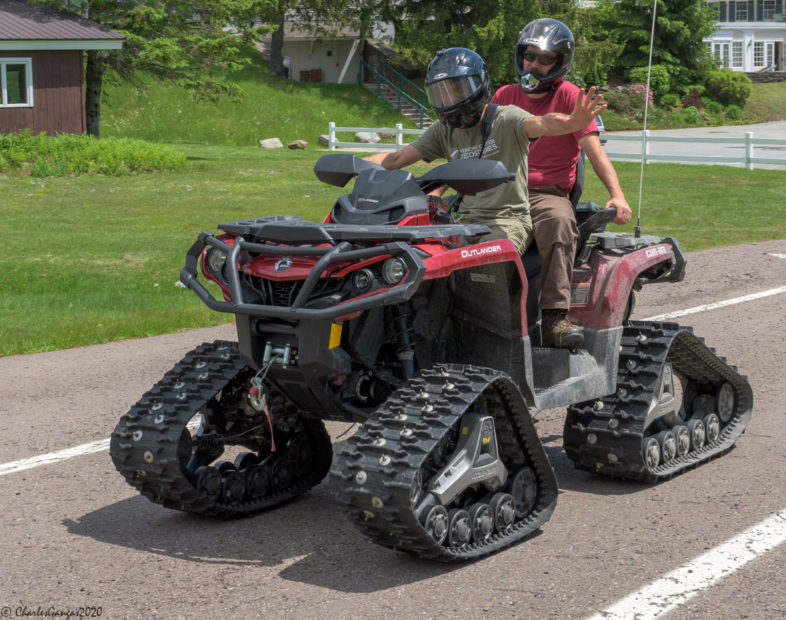
Not VCE’s typical mode of transport up Mt. Mansfield: Chris Rimmer and Noel Dodge prepare to ascend the toll road (currently closed to vehicles) on a WCAX ATV. Look out Evel Knievel! © Charles Gangas
Changed times call for innovative action. We never dreamed of launching VCE’s 29th consecutive field season on Mt. Mansfield via a toll road ascent on motorized ATVs, but it sure beat hiking up with all our gear. Facing the road’s COVID-related closure, with no prospect of an imminent opening, Vermont Fish & Wildlife colleague Noel Dodge and I couldn’t have been more grateful for a mechanized boost from cooperative (and sympathetic) partners Dave Turner at WVNY and Fred Lavenberg at WCAX. We met them at the toll road base during late morning on June 4. Both had hitched small trailers to their ATVs, and we piled in net poles, two trunks of nets and banding gear, a folding table, and our backpacks. Fred then asked, “Which of you is going to drive the third ATV?”. I’ll admit that I was quick to volunteer.
We had timed our inaugural 2020 banding session to coincide with a perfect weather forecast—vital with no available shelter in vehicles or buildings on the ridgeline, as we’d had each of the previous 28 years. Undaunted, we brought tents if needed, but planned to sleep under the stars. First, however, we had work to do. The 4-mile ascent proceeded without incident (well, except for the trailer behind Dave’s ATV coming unhitched and pitching some of our gear unceremoniously into the road—no damage done), and we were left to our own devices in the upper parking lot by 1 pm, a record early arrival. Bicknell’s Thrushes (BITH) were calling within minutes, either taunting or welcoming us, we couldn’t be sure.
We set mist nets over the next 2+ hours, managing to open 19 by evening; not quite our usual complement of 25, but all we could manage with just the two of us. Skies were mostly clear, temperatures comfortable, winds light. BITH were the most vocally conspicuous species as afternoon faded into evening, with at least 10 birds calling and singing around us. Our first 2020 capture was a unbanded male Blackpoll Warbler, not long returned from its distant wintering grounds in northern South America. By the time darkness settled at 9:15 pm, and we closed our nets, we’d captured 30 individuals of six species, including 6 BITH, one of which was a female banded as a yearling in June of 2016. The rising near-full moon traced a bright arc past the Nose above us, and we enjoyed the ridgeline’s solitude, as 2 or 3 BITH performed animated twilight flight songs. No retreat down the toll road to our ski patrol hut digs this visit—we rolled out pads and sleeping bags right on the gravel parking lot.
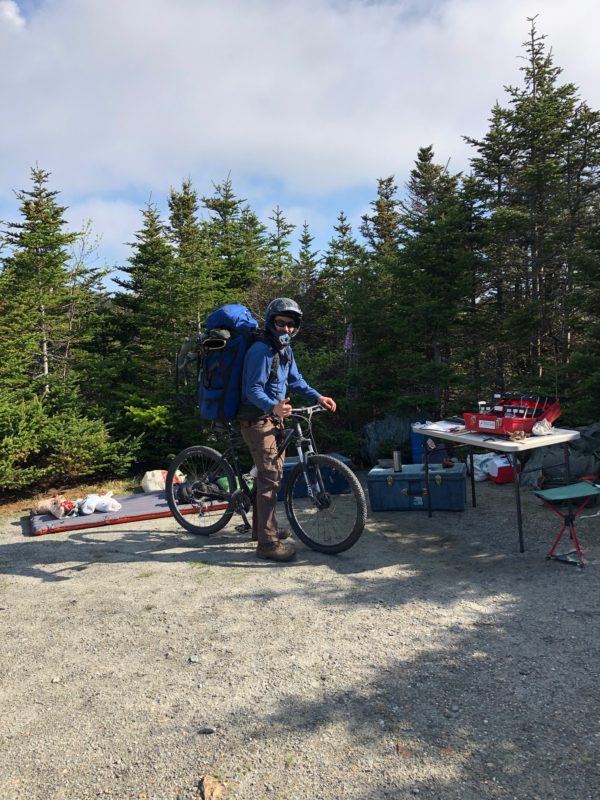
Noel Dodge prepares for his descent down the Mansfield toll road from the VCE banding “station”, 5 June 2020.
After being awakened periodically (but only briefly) by singing and calling BITH throughout the night—stimulated no doubt by moonlight—the dawn chorus was gathering steam as we clambered out of our bags at 4 am. Robins and BITH led the way, and we had nets open by 4:30. Cool, but reasonably calm and cloud-free conditions prevailed. Fueled by Noel’s Old Dodge Farm coffee, we welcomed a steady but manageable procession of birds over the next 6 hours. Noel peeled off on his mountain bike at 8:30 am for a VFWD site visit, and I wrapped things up by noon. By morning’s end we had captured another 30 individuals, including 4 Yellow-bellied Flycatchers (adding to our 2 the previous evening for an all-time single visit record), 4 more BITH, and another 6 Blackpolls. A subtly-plumaged but stunning female Canada Warbler was a nice surprise. Interestingly, we heard only one Swainson’s Thrush on the ridgeline, and none appeared in our nets, bringing into question the recent trend many have noticed of upslope movement by this close relative and potential competitor of BITH.
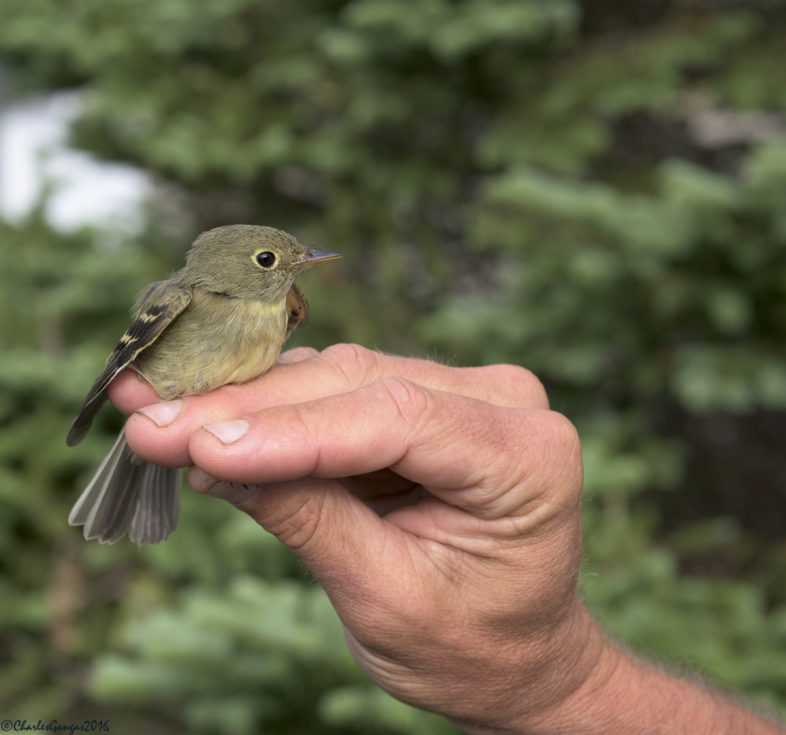
A Yellow-bellied Flycatcher banded on Mt. Mansfield in 2016. This long-distance boreal migrant places its well-concealed nest on the ground under roots of a fallen tree, tucked in a small crevice on a moss-laden rocky ledge, or nestled in moss at the base of a fern. Its “che-lek” song and plaintive whistled “tu-wee” calls are distinctive. © Charles Gangas
Our two-day banding total of 60 individuals was short on species diversity but solid on numbers of individual birds, a far cry from our results a year ago:
Yellow-bellied Flycatcher — 6 new bandings
Bicknell’s Thrush — 10 (5 new bandings, 5 recaptures from previous years [1 female 2016, 4 males 2018-19]; 9 males and 1 female)
American Robin — 3 new bandings; 2 females with fully-developed incubation patches
Purple Finch — 3 new bandings (2 ASY males, 1 female w/well-developed incubation patch)
Dark-eyed Junco (Slate-colored) — 11 (10 new bandings, 1 previous day retrap)
White-throated Sparrow — 8 (7 new bandings, 1 retrap male from 2019; female with well-developed incubation patch)
Blackpoll Warbler — 12 (10 new bandings, 1 retrap female from 2018; 6 males and 6 females)
Yellow-rumped Warbler (Myrtle) — 6 (4 new bandings, 2 retrap males [2016 and 2018])
Canada Warbler — 1 new female
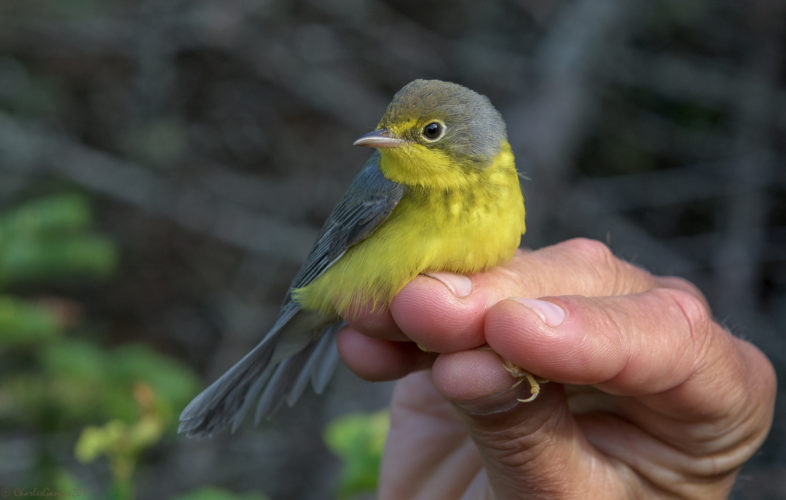
A female Canada Warbler banded on Mansfield (OK, not the same individual we banded on 5 June, but very similar in appearance and a much better photo than our iPhones managed to capture). © Charles Gangas
One week does not a field season make, but given COVID-related logistic constraints, we’re pleased with this strong start to year #29 on Mansfield. We can only hope that weather holds for upcoming sessions on the ridgeline. As always, we plan to be up there every week through July, and if physical distancing requirements subside—as we all so eagerly hope they do—we’ll welcome visitors to our long-term study site. In the meantime, we’ll savor having the ridgeline mostly to ourselves, and we’ll provide weekly updates.
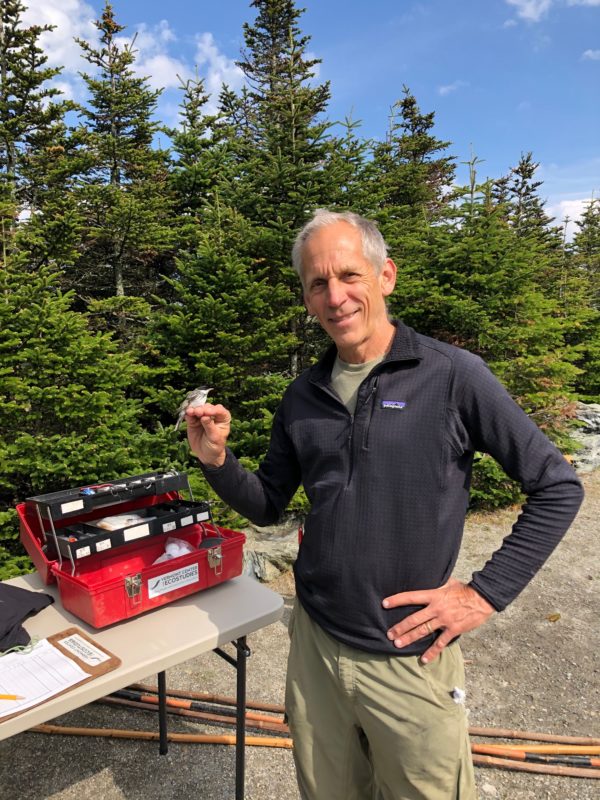
Old Man on the Mountain: CCR with the first Mansfield mist net capture of 2020, a male Blackpoll Warbler, on 4 June.

Chris et al deserve a medal for their dedication to BITH!
Very nice Chris. Twenty-nine quick years………..maybe not for you but it sure has been for me. You, Kent et. all have done a fantastic job.
Stay safe and wash your hands.
Great that you had an ‘uphill assist’, but seems like a wheeled vehicle would have made far less of an impact on the road surface than that quad-track. Thanks for the newsy report.
Hi Ruth, to put your mind at ease, the tracks actually distribute the weight of the vehicle over a much larger footprint than a wheeled vehicle, thereby reducing the pounds per square inch of vehicle contact, which very much reduces the impact over whatever surface it’s travelling over. They also increase traction, which reduces damage and ruts caused by wheel spin.
Win Win as they say.
Ray